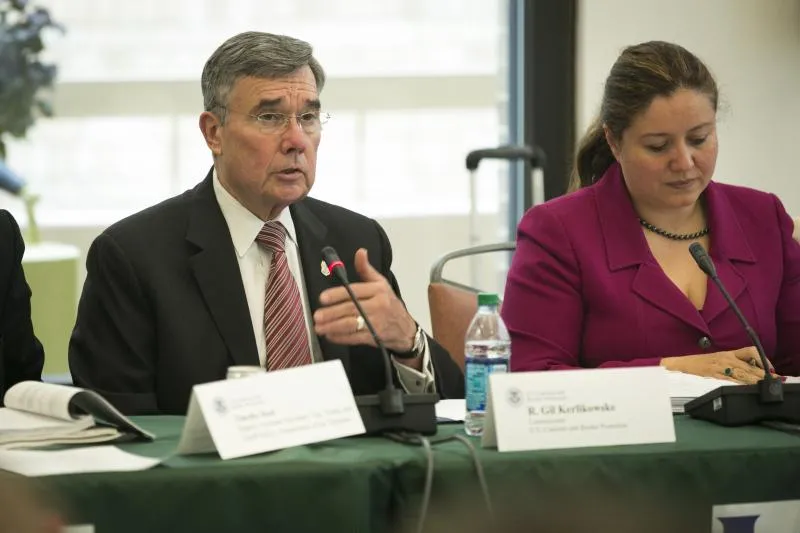In his opening remarks on Oct. 7 to the Advisory Committee on Commercial Operations of Customs and Border Protection, known as COAC, Customs and Border Protection Commissioner R. Gil Kerlikowske congratulated member participants on a productive year.

“At the beginning of this session, we challenged ourselves to tackle some of the lingering issues that impact trade and our nation’s economic competitiveness,” Commissioner Kerlikowske said. “You rose to the challenge and provided us with your innovative ideas, your considerable expertise—and your valuable time.”
The advisory committee convened in Washington, D.C., for its third quarterly public meeting of its 13th term.
Commissioner Kerlikowske welcomed a delegation of representatives from the Dominican Republic, Guatemala, Peru, and Uruguay, as part of the Pathways to Prosperity program. “Our Pathway partner countries promote economic growth in the Western Hemisphere and these member delegates are here today to observe the public-private dialogue between ACE’s Trade Support Network and COAC,” he noted. The Trade Support Network was established in 1994 to provide a forum for the discussion of significant improvements to CBP’s trade facilitation efforts with trade industry stakeholders.
Commissioner Kerlikowske also emphasized CBP’s deep commitment to working with other government entities to cut trade processing and approval times for imports and exports by migrating to the One U.S. Government at the Border “Single Window.” CBP’s Automated Commercial Environment (ACE) is the technology enabling the Single Window process.
“As we build the Single Window, our partnerships with other government agencies are growing stronger, which increases our supply chain efficiency and our economic competitiveness,” he said.
CBP began implementing the Single Window earlier this year when CBP, the Food Safety and Inspection Service, and the Environmental Protection Agency started testing technical capabilities at pilot locations with pre-identified industry partners.
The second phase, beginning in spring 2015, will include imports and exports and will expand capabilities and industry users. By December 2016, trade users will be required to submit electronic data and documentation via ACE to import and export cargo.
Advisory committee members also reviewed and discussed the preliminary results of the 2014 Trade Efficiency Survey, which was distributed to trade associations, customs brokers, freight-forwarders, and other service providers. Ninety-eight percent of the respondents are members of CBP’s Customs-Trade Partnership Against Terrorism program.
This year’s survey gathered more information than in previous years, with 1,674 respondents in 2014, compared to 521 in 2012 and 815 in 2013. Not only did the survey double the number of participants this year, for the first time the survey included both imports and exports, resulting in a more comprehensive picture of supply chain dynamics. According to the survey, 83 percent of respondents rated themselves “satisfied” with CBP’s trade facilitation efforts – up 2 percent from the last survey.
In another key development at the meeting, the advisory committee approved and submitted the findings of the One U.S. Government at the Border Import Mapping Working Group, which provides industry feedback on how current U.S. import processes affect trade facilitation.

Julie Parks, second from right, lead of the COAC 2014 Trade Efficiency Survey project, discusses the survey findings. Other COAC members, left to right: Susie Hoeger, Mary Ann Comstock, Liz Merritt, and Kathy Neal. Photo Credit: James Tourtellotte
The working group brought together subject matter experts to develop process flows for five distinct modes of transportation: air (conventional); air (express); sea; truck; and rail. The working group’s maps present a high-level overview of the current import process via transportation mode, identifying the flow of data, cargo, and documentation, as well as the various parties involved in each step of the process.
The results help document CBP’s data-gathering pathways as well as those employed by partner government agencies. The Import Mapping Working Group proposed various possible improvements to create a more streamlined import process to benefit government entities and trade stakeholders.
The One U.S. Government at the Border subcommittee also approved the recommendations and findings of the Food and Drug Administration Working Group. This group represents the pharmaceutical, medical device, and food sectors, as well as express carriers and brokers.
The FDA working group’s primary goal was to develop recommendations to improve the quality of data submitted to the FDA and reduce the number of submissions that do not pass the automated screening process. As the FDA begins implementing Single Window, reducing the number of rejections will enable it to redeploy resources to address higher-risk shipments.
CBP applauded the findings and recommendations of the working groups and congratulated the participants on the collaborative effort.
“We at CBP understand that one of the areas that is key to the success of our Single Window implementation is the partnership with industry and other government agencies,” said Maria Luisa Boyce, senior advisor, Private Sector Engagement, CBP Office of Trade Relations.
Boyce, the designated federal officer for COAC, added that “the recommendations presented to us by COAC on the mapping of the import process and the FDA working group provide us with key tools that will support our efforts to improve the global supply chain and our economy.”


